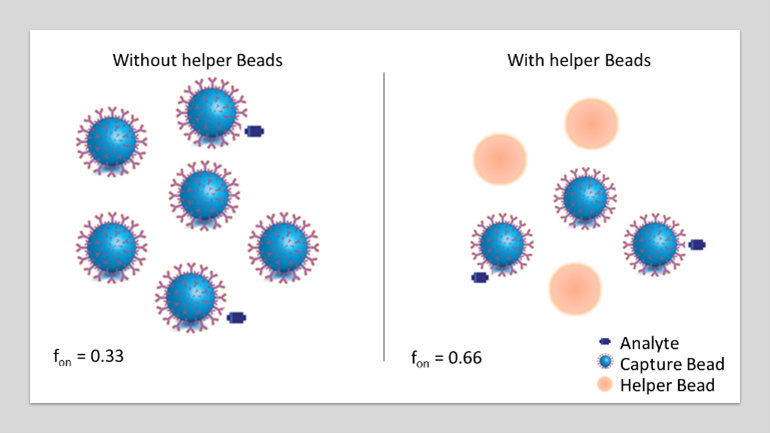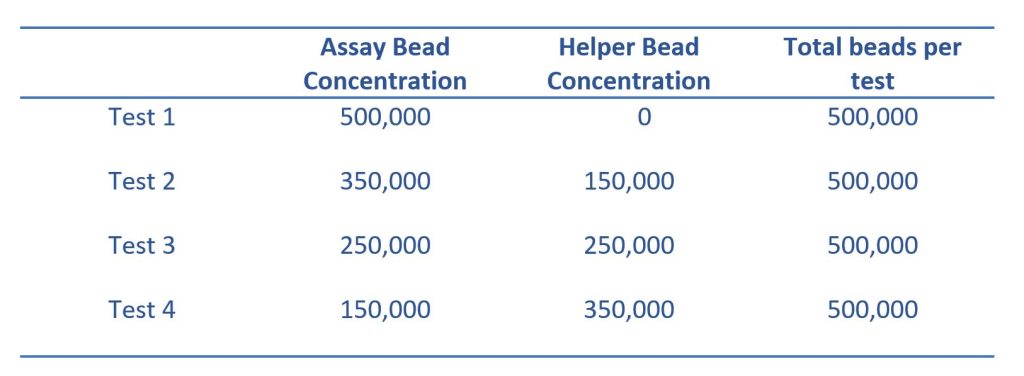
Enhancing Sensitivity in Simoa® Homebrew Assays: Leveraging Helper Beads
By Danielle Fontaine, PhD
Quanterix Field Applications Scientist
Quanterix Simoa® immunoassays have revolutionized biomarker detection through their ultra-sensitivity. One strategy to further enhance this sensitivity during Homebrew Custom Assay Development is through the use of dye-encoded helper beads. This article aims to provide users of Quanterix’s HD-1, HD-X, or SR-X platforms with valuable insights into the benefits of using helper beads and guidelines for optimizing their assays.
The Role of Helper Beads in Simoa® Homebrew Custom Development Assays
Helper beads are non-functional, dyed beads that are combined with assay beads in the Bead Reagent Bottle used in Homebrew assay preparation. This unique combination allows for a reduction in the total number of assay beads used per sample without compromising the size and formation of bead pellets during the wash steps. Without altering total bead number loaded into the array, the fraction of positive assay beads increases, by improving the analyte to bead ratio. This effectively amplifies the signal for samples with low analyte levels and enhancing overall assay sensitivity.

Optimizing Assays Using Helper Beads
To achieve optimal results, specific guidelines for bead concentrations should be followed when employing helper beads in Simoa® Homebrew assays. It is recommended to maintain a minimum assay bead concentration of 150,000 beads per test while ensuring a minimum total bead concentration of 500,000 beads per test. Lower assay bead concentrations can be explored by following the experimental design outlined in Table 1, which provides a systematic approach to evaluating assay performance at reduced bead concentrations.

Key Considerations During Assay Development
During the development of assays incorporating helper beads, several key considerations should be kept in mind. Generating robust calibration curves through duplicates of at least a 5-point calibration curve is essential. Additional attention should be given to the limit of detection (LOD), lower limit of quantification (LLOQ), coefficient of variation (CV), and signal to noise values. High CVs (>20%) in low-level calibrators indicate higher assay variability, necessitating the use of a higher concentration of assay beads to improve precision. In addition, helper beads are generally incorporated into assays once the performance of an assay is reasonably well understood, and other optimization steps have been attempted.
Proper Utilization of Helper Beads
Accurate analysis and well classification rely on utilizing correct Homebrew Helper assay definitions or analysis protocols designed for the respective platforms. For HD-1, HD-X, and SR-X instruments, specific assay definitions/analysis protocols can be obtained from the Quanterix Customer Portal. Please note that all beads provided by Quanterix have moved to the dyed-beads platform, and choosing the correct assay definition for dyed-beads is critical to prevent data loss.
Summary
Incorporating helper beads in Simoa® Homebrew assays presents researchers with the opportunity to enhance detection sensitivity. By reducing the number of assay beads without compromising bead pellet formation, the fraction of positive assay beads increases, thereby amplifying the signal for low analyte levels. Adhering to recommended protocols, utilizing proper assay definitions, and following optimized bead concentration guidelines are crucial to ensure reliable and accurate analysis of Homebrew Assays incorporating helper beads.
Remember, if you require further support or have any questions regarding Simoa Homebrew products and Homebrew Assay Development, reach out to techsupport@quanterix.com for assistance.
Additional Resources
Have a question about helper beads that was not addressed here? You can find more information on our Customer Portal. The following Customer Portal documents are recommended: 488 Dyed Singleplex Assay Beads, Homebrew Assays with Helper Beads, and Setting up Homebrew Assays with Helper Beads. For assistance with experimental design for assay performance evaluation or for any other questions regarding Simoa® assays, please contact TechSupport@Quanterix.com